 Several years ago I was able to pick up a copy of Warhammer Quest Silver Tower and loved it. Many of the Warhammer Quest branded board games are large boxes stuffed full of tiles and several sprues of bits requiring hours to build your miniatures before you even get a chance to play. The hobby aspect may not appeal to everyone but the games were fun. Barnes and Noble have an introductory line of Games Workshop games like Space Marine Adventures and Blitz Bowl that come in smaller packages, with streamlined rules, and snap-fit miniatures. Warhammer Quest Lost Relics is the first in that line for Warhammer Quest (although there have been a few other Age of Sigmar releases).
Several years ago I was able to pick up a copy of Warhammer Quest Silver Tower and loved it. Many of the Warhammer Quest branded board games are large boxes stuffed full of tiles and several sprues of bits requiring hours to build your miniatures before you even get a chance to play. The hobby aspect may not appeal to everyone but the games were fun. Barnes and Noble have an introductory line of Games Workshop games like Space Marine Adventures and Blitz Bowl that come in smaller packages, with streamlined rules, and snap-fit miniatures. Warhammer Quest Lost Relics is the first in that line for Warhammer Quest (although there have been a few other Age of Sigmar releases).
I really enjoyed Space Marine Adventures Doomsday Countdown last year with my biggest complaint being a lack of a real campaign. Lost Relics has a campaign and it’s Warhammer Quest so both things are appealing. Read on to see where it stands next to its BN 40K neighbor.
Gameplay Overview:
Each game of Lost Relics uses all four Stormcast Eternal heroes. There’s quite a lot going on in this game so this overview will focus on key concepts while glossing over some minute details. Each turn is broken down into the following phases:
• Adventure Phase – Special rules for each adventure but often involves moving and having hostiles attack the heroes
• Dice Phase – Each hero rolls their 3 six-sided dice
• Initiative Phase – Shuffle the initiative cards for the four heroes and place them in order
• Action Phase – Active the heroes in order one die at a time. After each activation, one enemy gets a reaction (more on that below)
• Leader Phase – Each leader on the board takes a leader action
• Refresh Phase – Returns out of action heroes if you’re adjacent to a Haven space
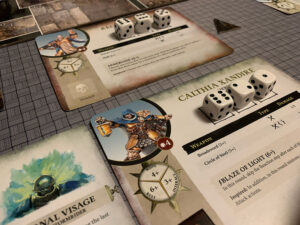
The aptly named action phase is where the action happens. But with every action, there’s a reaction following it making Lost Relics seem like watching a Newtonian cradle play out on the table. To break up the back and forth you’re going to need action chains. An Action chain is when you play consecutive numbers starting at one from the active hero but continuing using the available dice from any hero. After the last action of that action chain, one visible enemy gets a reaction.
On the hero cards there are values for move, interact, and combat that represent when those become inspired, improving the base action. Many combat abilities have their own inspired value and often do more damage or have some extra effect. Minions, if you don’t do the damage listed on their cards are flipped over to a wounded side meaning that minions can be defeated with any two small attacks. While bosses have the health listed on their cards that you need to whittle down to zero to defeat. Heroes cards get flipped when they take the damage listed on their card and then are out of action if the same thing happens on their wounded side.
Leaders get an extra turn during the leader phase where they can do something special, often summoning more minions, or getting an extra reaction/activation.
Each of the missions has its own special rules along with win and lose conditions and ways to earn destiny tokens, which can be used to manipulate one die to any face.
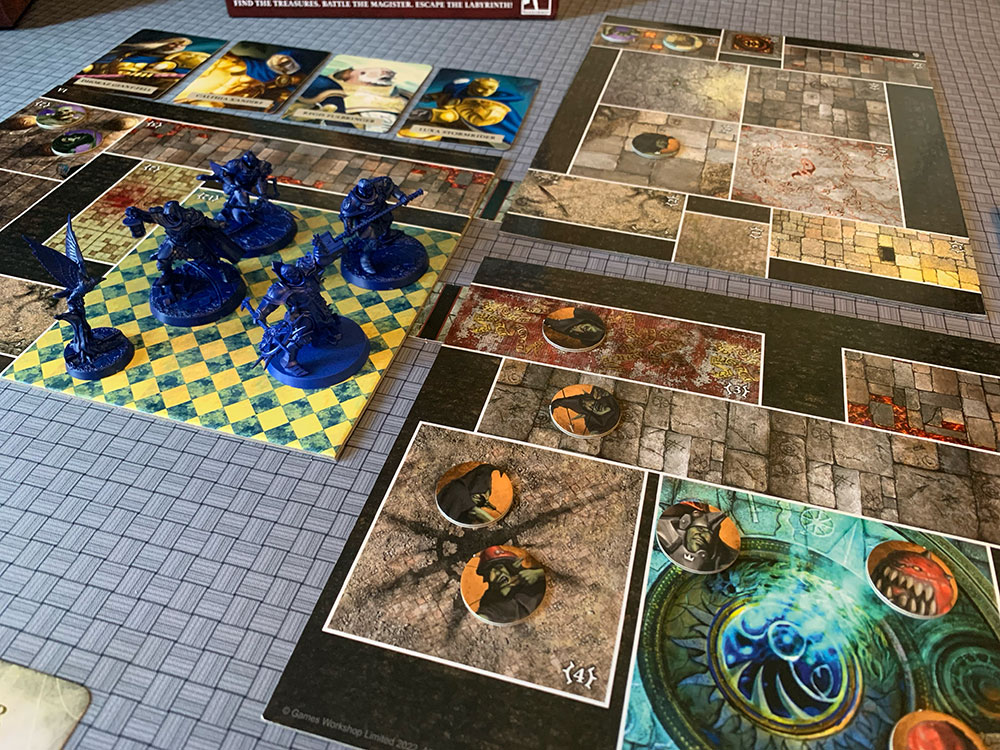
Game Experience:
I love the basic dice allocation mechanic that’s in Lost Relics as well as in older Warhammer Quest games like Silver Tower. But in Silver Tower, you still had to roll to hit after deciding to use that die. Removing that randomized step makes the game more deterministic which is cool when you’re laying the beat down on some enemies but isn’t as fun when they get to automatically damage you. Likewise, deterministic enemy activations take away some of the good chaos that rolling for behavior gave. Due to these changes, Lost Relics really favors tactical thinking through your and the ensuing enemies turns more than Leroy Jenkins-ing your way through the dungeon.
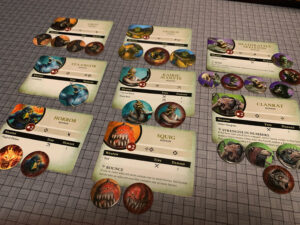
The reaction system isn’t the most intuitive and I found myself questioning if I was playing right. I assumed the one enemy that gets a reaction would do all of the actions on their card in that order, skipping steps that couldn’t be completed. Using action chains is the best way to reduce the number of reactions the enemies get but that depends on both your dice rolls and your initiative cards. If the only 1 you rolled is on your fourth character, no chains for you. But if you roll very lucky and put together a few solid chains, you can steamroll a scenario.
Gear can either be single-use or permanent (often with once per scenario uses) but it often didn’t feel worth the effort to go out of my way. This might be something I regret down the road when I’m gearless and facing tougher enemies, but we’ll see. As far as I can tell through six scenarios, there’s no character leveling which is kind of disappointing in a campaign game.
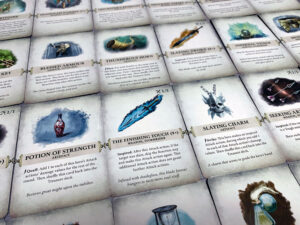
With all of that, was the game fun? Sort of but I’m kind of on the fence with this one. The stilted flow of the game of alternating actions with enemies can grind the game to a halt as you ponder your move and your enemies’ potential moves. Or you can chain together several actions and wipe a room of enemies out without fear of reprisal. I’ve played six scenarios as I type this and I’m still slowly having to reference enemy and leader cards on almost every turn.
On the positive side, the dungeons are generally set up very quickly as there are only four double-sided boards to arrange plus some tokens. The images in the campaign book were hard to see so I used the magnifier I use for painting to see what some of the enemies were and to see some scenario-specific icons (As an aside I highly recommend these for miniature painters. The unique art on each token made it a little difficult to figure out who was who at first as each enemy card only features one of the pictures. Additionally, the wounded side of the token can be hard to see on some of these tokens.
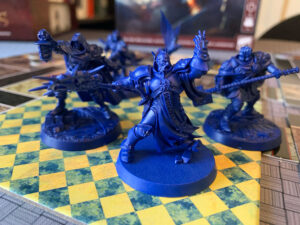
The minis are standard Games Workshop snap-fit quality (so pretty cool). It took about 45 minutes to break free and snap the five figures together. I would recommend using cutters if you have them as I broke the bowstring on one of them when I detached it from the sprue. One of the figures, strangely, has a plain base except for a few rock pieces that get inserted compared to the others with fully sculpted bases.
Final Thoughts:
There was something in the deterministic nature of the dice activation system that just removed some of the fun from the traditional Warhammer Quest formula, but this might be a plus for some people (and if that’s you, then this may be a great game for you). Meanwhile, the reaction system didn’t really click for me as I found I could get through levels in a few turns if I was lucky or lose all my heroes just as fast if I wasn’t ultra-careful. The net result was I didn’t enjoy Lost Relics as much as Doomsday Countdown or the old Warhammer Quest Silver Tower game.
Final score: 2.5 Stars – Deterministic system may appeal to some but it didn’t capture the magic of previous Warhammer Quest titles.
 Hits:
Hits:
• Deterministic system allows players to think through their actions
• Fairly quick to set up and play
• Action chains are fun to plan out
Misses:
• Deterministic system can sometimes make the game too easy
• Hard to decipher the scenarios in the book
• Luck plays a large part in getting to use action chains





















